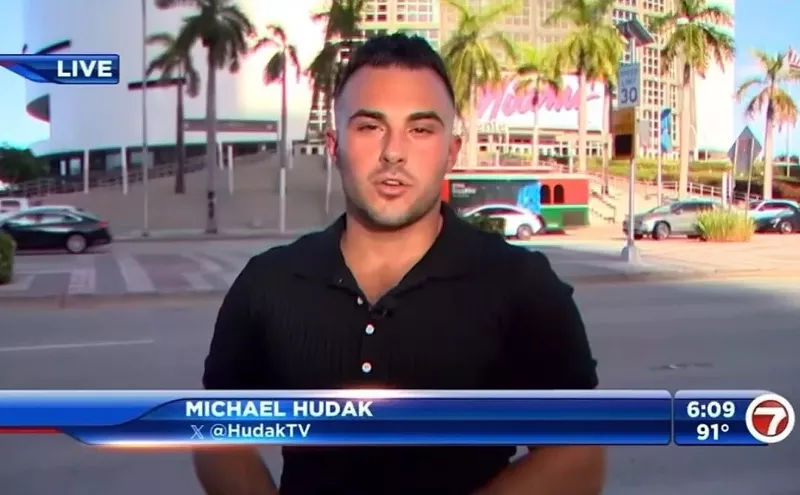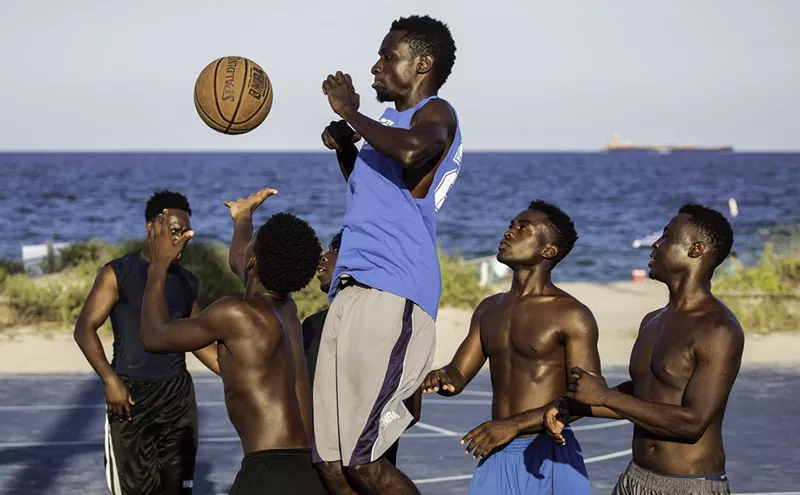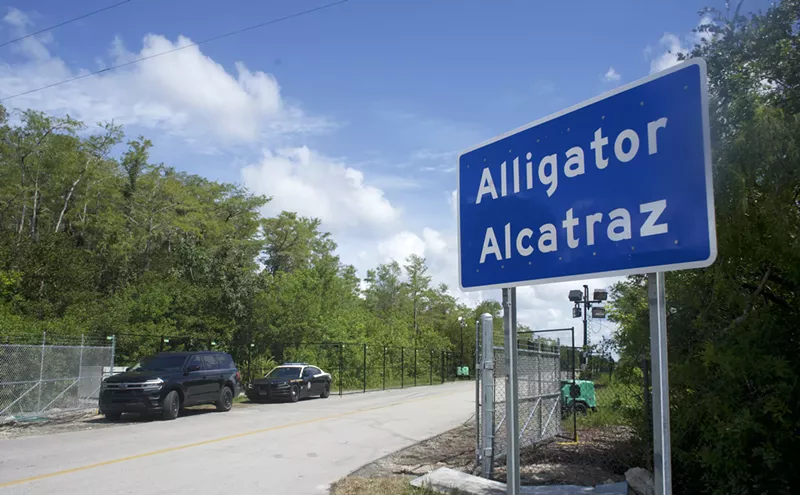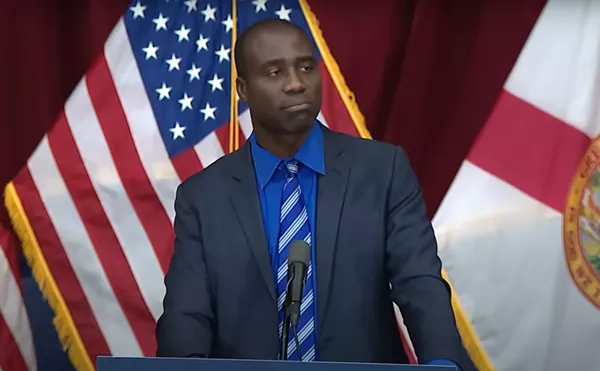"Turn around!" shouted an officer who'd stepped out of the line and pointed at me with his baton.
"I need to go downtown," I told him, holding up the Miami New Times press credentials clipped to my jacket.
"You can't go downtown!" he yelled. "It's an emergency!"
As in a State of Emergency? I asked myself. Has martial law been declared? Not last I checked, and I'd left my office just five minutes earlier. I had no idea what was happening downtown at that moment, but if it truly was an emergency, I had a job to do as a reporter. That's what I get paid for.
A group of young protesters from Gunnison, Colorado, had agreed to meet me at the center of town. I'd been heading south on First Avenue from Twelfth Street when I encountered the black tide that was now advancing to the steady rhythm of clubs striking shields, a tactic meant to intimidate and send crowds scurrying -- but the only crowd here was me.
I spun and reversed direction, walking north ahead of the fast-moving police line. The downtown appointment would have to wait. Instead I decided to go to the Convergence Center, the warehouse at North Miami Avenue and 23rd Street where FTAA protesters had been headquartered for the past several days. At the next intersection I turned the corner and waited for the police to march past me. Another cop ordered me off the street.
On my way to the Convergence Center I saw another field force of police in riot gear at Miami Avenue and Fourteenth Street. Hoping to avoid confrontation, I sat down on the corner and slowly took off my backpack, careful to keep it in full view of the police as I pulled out a notebook and pen. Just then I noticed four young men approaching the opposite corner and recognized 24-year-old Austin Stewart, leader of the Gunnison Peace Initiative, the people I was supposed to meet downtown and whom I'd been hosting at my North Miami home as part of an assignment to produce an intimate portrait of a group of FTAA protesters.
I jumped up, waved, and joined them. We stood on the corner as a convoy of more than twenty squad cars squealed by, headed farther west, sirens blaring. The street was deserted. The sun was setting. Together we began hiking up North Miami Avenue en route to the Convergence Center and, if necessary, all the way up to my house.
It was nearly dark when another group of young people, walking south, met us on the sidewalk. "Don't go to the Convergence Center," a girl advised us. "They're evacuating. They're taking people out on buses." Well, we had to go in that direction anyway, so we crossed to the east side of the avenue. At least we'd be on the opposite side of the street from the center. We weren't the only ones trekking north; other clusters of people were in front of us and behind us.
Suddenly a Miami-Dade Police Department squad car came hurtling south down Miami Avenue, doors wide open. The car swerved across the oncoming lane, climbed the curb, and screeched to a halt on the swale in front of us.
"Get down!" four officers shouted as they leaped from the car. "Get on the ground!"
We dropped to the ground.
Throughout the day I'd witnessed police provoke protesters. I'd seen young people cuffed and lined up along the street, but I thought they must have done something bad to be detained. Surely the police would see that we were doing nothing wrong and let us go. Surely they would recognize my role as a working member of the press.
"I'm a reporter with New Times," I said to the brown-shirted behemoth in a helmet who hovered over me. I pulled out my press pass, which included a color photograph of me.
"Put your hands behind your back," the cop ordered without looking at what I held in my hand. I wiggled out of my backpack, put my press pass inside, slid the pack along the ground above my head, then clasped my hands behind me.
"Do yourselves a favor and turn your head to the right," the officer commanded us. I obeyed. One of the Gunnison men, 23-year-old deli worker Nate Stewart (Austin's brother), told me later that he continued looking left. He saw the officers surround a shirtless man with black hair and a huge tattoo at the small of his back. The police raised their clubs. Nate turned his head to the right.
We were handcuffed with plastic cable ties pulled so tight that within fifteen minutes my wrists began to swell and my hands tingled.
Lying on my belly in the dark, I heard a woman call my name in Spanish: "Celeste, is that you?" I raised my head to see a friend's face poking out of a passing car. The police ordered her to move on, but she returned on foot. I explained what happened and asked her to call my mom and my editor.
The police picked up the women first. A female officer told me to spread my legs and put my head against a prisoner transport truck that had arrived on the scene. While she frisked me, I repeated that I was a journalist and that my credentials and my notebook were in my black leather backpack nearby. She wasn't interested in the fact that I was a reporter, but did reassure me that my belongings would be waiting for me when I was released.
The officer removed my driver's license and a stack of New Times business cards from my jacket pocket, looked them over, then replaced them. Another officer untied my hiking boots and checked my socks for weapons. Onboard the paddy wagon were others arrested at the same time, the women separated from the men by a metal barrier. The Stewart brothers were there, and young Nate later told me about being frisked by two officers before being loaded onto the van. "One was mean and the other guy was really nice," he recounted. The mean cop ground his heel into Nate's foot and growled in his ear: "Welcome to fucking Miami. How do you like it here?"
Three paddy wagons filled with as many as eight people each finally began speeding toward the Biscayne Boulevard parking lots just south of the Freedom Tower. Here a group of officers waited to fill out arrest reports. "I want you to know I'm not comfortable with this," a ponytailed female officer said to a male officer named Manny, who wore a star-spangled bandanna. She wasn't worried about us; she didn't like the way the reports were shaping up. Manny agreed to a rewrite. At one point another officer complained: "We don't even know what they're charged with. This is so fucking stupid."
Finally the police settled on the following narrative for me and the four guys from Gunnison: "Defendant was observed in the area of NW Nineteenth Street and N. Miami Ave. with a group of individuals which matched description of people who were throwing rocks due to FTAA protests. Defendant was approached and asked to stop and refused. Defendant subsequently taken into custody without incident." None of us, of course, threw any rocks. And all of us instantly stopped when we were told to do so. Still I was slapped with two misdemeanor charges: one count of "failure to obey a lawful command" and one count of "resisting [arrest] w/o violence."
In time we were taken to the Earlington Heights Metrorail station along State Road 112 near NW 22nd Avenue. The parking garage there had been converted into a holding area for FTAA prisoners. Two young activists who'd been arrested with me -- "Porch," a massage therapist who worried about nerve damage because her cuffs were so tight; and a woman I called Houdini, a double-jointed anarchist who taunted police by rotating her arms from behind her back to her front -- were processed quickly because they refused to provide any personal information. They called it "jail solidarity," an act they hoped would clog the court system and give them leverage in having their charges dropped.
We ended up in a chainlink cage with an Italian girl who was singing the Bob Marley anthem "Get Up, Stand Up (for Your Rights)." Artist Claudia LaBianca knew nothing about the FTAA protests, but with her wild hair, paint-spackled shorts, and unshaven armpits, she could have passed for an anarchist. She and her blond-dreadlocked boyfriend had ventured out from her Overtown studio to visit a friend in an apartment building near Miami Avenue. Without warning police stormed the building, grabbed the pair out of the elevator, and placed them under arrest.
LaBianca noticed Laura Winter sobbing in the cage next door. Winter is a secretary with the United Steelworkers of America who was caught in the dragnet while trying to get back to her hotel. "It's all right," the artist consoled her, then belted out the classic Mexican folk tune "Cielito Lindo": "Ay ay ay ay ay/Sing and don't cry."
When a guard with a handful of plastic cuffs walked down an aisle between the cages, 71-year-old prisoner Bentley Killmon pleaded with him to loosen his handcuffs. Soon everyone in the holding area was chanting: "Change his cuffs! Change his cuffs!" The handcuff man relented. He had Killmon pulled out of the cage and tied on a new pair of cuffs before cutting off the old in case the retired airline pilot from Fort Myers became violent.
One by one we were taken from the cages and processed a second time at a row of card tables manned by Miami-Dade corrections officers, where we were relieved of any possessions left in our pockets. Anyone wearing boots had those removed too, so I slogged around for the rest of the night in my socks. At least the handcuffs were cut off from behind my back and a new pair put on with my hands in front -- although still too tight. Two officers escorted each of us to another paddy wagon.
I was shoved in next to a woman in her early forties who looked more like a nun than an anarchist. She identified herself as Bork and said she works in a soup kitchen in Washington, D.C. Later, in the holding cell, she told me she'd been arrested 27 times in the past three years for actions that ranged from taking over abandoned houses for the homeless in D.C. to chaining herself to the gates of the United Nations, trapping Secretary of State Colin Powell inside for 45 minutes while insisting he could not come out until he made peace in the Middle East.
"I thought they let me behind the police line because I look like a harmless soup-kitchen lady," she told me. But when she was arrested late Thursday afternoon, for "endangering police," she discovered that the cops already knew her identity. "I think they let me sit there because they wanted to keep an eye on me," she said.
As Bork talked, a teenager with bright pink hair was pushed in beside me. She'd been beaten pretty badly; there was a raw gash on the bridge of her nose and contusions on her forehead and cheeks. She reeked of whiskey. "I was just marching and all of a sudden the cops started hitting me, man," she told me later. But when she got into the paddy wagon she was too disturbed for conversation, screaming and swearing and kicking the truck's steel wall. Bork calmed her down in a soothing voice.
The last to slide in was a frail college student I called Kitten. She said she was 21 but with her tiny five-foot frame and pouty oval face, she looked more like 12. She was arrested at gunpoint by a SWAT team after she and three strangers tried to hide in an abandoned downtown building when a fracas broke out following the officially sanctioned protest march. "I just don't like how it feels in here," she whined, head doubled over her knees.
"We all feel that way," Bork comforted her. "That's okay."
For the next three hours at the Turner Guilford Knight Correctional Center in west Miami-Dade we were herded from holding cell to holding cell, tiny concrete-block rooms equipped with a toilet and a metal bench. Pink Hair was put in a room by herself, screaming and jumping on the bench. Porch, Houdini, and Bork consulted on jail strategy. When we were at last allowed to make a phone call, I learned from my mother that my backpack would not be returned to me upon my release. As it turned out, the cops had simply discarded it, along with the possessions of many others detained. By sheer coincidence, attorney and former Miami ACLU president John De Leon came upon the scattered piles of personal effects while inspecting the neighborhood south of the Convergence Center. He scooped up the items and held them for safekeeping.
We spent the night in cold cells at TGK, listening to Pink Hair rage. The next morning we met with public defenders, handcuffed together in groups of eighteen. We were told we had three choices: plead guilty, plead not guilty (then wait in jail until someone posted our bail), or plead guilty with adjudication withheld -- which meant we would admit guilt, but because the charges were minor, they wouldn't appear on our records as criminal convictions. That was the quickest way to get out of jail, but it also meant you wouldn't be able to sue later for wrongful arrest.
The Jane Does -- Bork, Porch, and Houdini -- pleaded not guilty and bond was set at $5000 each. Kitten, Pink Hair, and Claudia the artist all accepted the guilty plea. "I am sorry," Claudia yelled to the rest of us, "but I have to be free!" Secure in the knowledge that the steelworkers union would support her, Laura Winter pleaded not guilty. I too was prepared to plead not guilty, but the prosecutor dropped the charges against me and against three out of the four Colorado men arrested with me; the fourth copped a plea. By Friday afternoon all five of us were out of jail.
That evening, when the five of us who'd been arrested were reunited at my house with the rest of the Gunnison Peace Initiative, the other members told their story of how the peaceful protest in downtown Miami had turned ugly. At precisely 4:00, they said, the entire line of police fronting the security perimeter at Biscayne Boulevard and Flagler Street slammed their batons into the stomachs of protesters without warning. The protesters fled but the police kept coming. One group of cops ran toward the Bayfront Park amphitheater, where they reportedly tear-gassed people who were quietly looking on.
Other squads of riot police herded protesters north and west. Black-clad anarchists took a stand near the federal courthouse, throwing rocks and dragging iron barriers into the street to set up a barricade between protesters and police. Around the corner from the courthouse, at Miami Avenue near Fifth Street, the Gunnison group said they saw riot police invade the storefront "Wellness Center," where medics were treating injured protesters. The cops allegedly fired pepper spray into the building and also sprayed the face of the woman at the front door.
Police drove the retreating protesters deep into Overtown, where they were detained and forced to dump their belongings onto the ground, but not arrested. Instead, the Gunnison group said, police told them they were in the "worst neighborhood in Miami" and then abandoned them to meet their fate -- except for the four young men who left the group before the downtown melee and ran into me. They were detained, arrested, charged with crimes, and sent to jail as I was -- for doing nothing but walking down the street.












